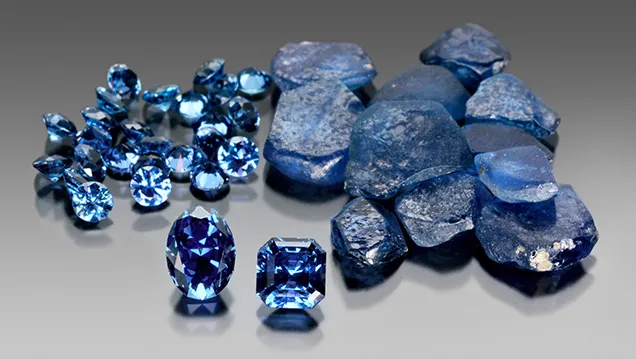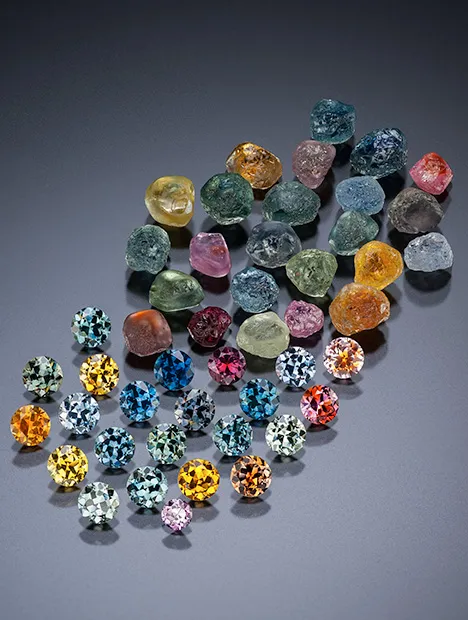Montana, with its pristine and majestic beauty of the American West, is renowned not only for its towering mountains and picturesque rivers but also as a treasure trove of gemstones hidden beneath its soil. Since the late 19th century, Montana has been a significant source of sapphires in the United States, attracting gem enthusiasts and travelers from around the world. Do you want to discover and find your own sparkling sapphires in this land? Join “Travel the World” as we explore a detailed guide to start your unique gem hunting adventure in Montana!
Montana – Gem Country: More Than Just Sapphires
When Montana gemstones are mentioned, sapphire is probably the most well-known name. However, this land hides many other types of precious stones, enriching the geological treasure of the United States. Besides sapphire, Montana is also a place to find agate, jasper, garnet, and even gold. This diversity makes Montana an ideal destination for those who want to experience the thrill of finding and discovering treasures from the earth with their own hands.
Yet, sapphire still holds a special place in Montana’s heart. With a long history of mining and unique beauty, Montana sapphire is not just a gemstone but also a symbol of this land. They are found in many different areas, each bringing its own shades and characteristics, creating diversity and appeal for Montana sapphires. This article will focus on the journey of discovering sapphire, the most famous and valuable gemstone in Montana, and provide you with the necessary guidance to start your own gem hunting adventure.
History of Montana Sapphire Mining: From Gold Rush to Jewelry Industry
The story of Montana sapphire began in the 1860s when gold prospectors accidentally discovered sparkling blue stones while panning for gold. Initially, they were disregarded and often thrown away. However, in 1865, these stones were identified as sapphires, opening a new chapter in Montana’s gem mining history.
In the early years, Montana sapphires were mainly mined from alluvial deposits along the Missouri River and its tributaries. In 1895, the discovery of the Yogo Gulch mine marked a significant turning point. This is the only primary deposit in Montana, where sapphires are found within the bedrock rather than in river sediments. Yogo sapphires are famous for their consistent, intense blue color, high clarity, and no heat treatment requirement, quickly becoming one of the most sought-after sapphires in the world.
From the early 20th century, Montana sapphires played an important role in industry, especially in watchmaking. However, the advent of synthetic sapphires reduced industrial demand. Fortunately, the natural beauty and uniqueness of Montana sapphires helped them find a firm foothold in the jewelry industry. Today, Montana sapphires are not only popular in the US market but also known worldwide, attracting gemstone lovers and collectors with their beauty and the historical story behind each stone.

Famous Sapphire Hunting Areas in Montana
Montana has four main sapphire mining areas, each offering sapphires with distinct characteristics:
Yogo Gulch Mine – “National Treasure” of Yogo Blue Sapphires
The Yogo Gulch mine, located near Utica, Montana, is famous for its unique Yogo sapphires. A special feature of the Yogo mine is that it is the only primary deposit in Montana, where sapphires are formed in lamprophyre dikes. Yogo sapphires have a distinctive “cornflower blue” color, the most highly valued shade of blue sapphire. They are also known for their excellent clarity and do not require heat treatment to enhance color.
However, Yogo sapphires are usually small in size, rarely exceeding 1 carat. Stones larger than 2 carats are extremely rare and valuable. Despite their modest size, Yogo sapphires are still known as the “national treasure” of the United States and are sought after by gem lovers worldwide. Currently, the Yogo Gulch mine is still operating and owned by Yogo Mining LLC, continuing to supply beautiful blue sapphires to the market.
Rock Creek/Gem Mountain Mine – Paradise of Multicolor Sapphires
The Rock Creek area, also known as Gem Mountain, located near Philipsburg, Montana, is one of the largest alluvial sapphire mining areas and has been continuously operating since the late 19th century. Rock Creek sapphires are famous for their color diversity, ranging from blue, green, yellow, pink, orange to purple. In particular, bicolor sapphires are a specialty of Rock Creek, with a unique combination of different colors on the same stone.
Rock Creek Mine is also an attractive tourist destination, especially Gem Mountain Sapphire Mine, where visitors can experience gravel panning and sapphire hunting themselves. This is a fun activity for families and those who want to try their luck at finding gemstones. Sapphires from Rock Creek often need to be heat treated to improve color and clarity, but natural, untreated stones are also highly valued and more valuable.

Missouri River – Sapphire Hunting Journey Along the Historic Flow
Along the upper Missouri River, near Helena, Montana, is a historic alluvial sapphire mining area. Sapphires are found in gravel layers along the riverbanks, where gold miners first discovered them in 1865. The Missouri River area has many small and historic mines, including Eldorado Bar, Spokane Bar, and American Bar.
Missouri River sapphires are often light blue, blue-green, or green, sometimes with pink, purple, and yellow hues. Some fairly large stones have been found in this area, even weighing nearly 50 carats. Today, some mines along the Missouri River are still active, mainly serving tourism and gem enthusiasts. Visitors can join sapphire mining tours or pan for gravel along the riverbanks themselves to find precious gems.
Eldorado Bar Mine, one of the historic sapphire mines along the Missouri River.
Dry Cottonwood Creek – Potential Destination for Gem Hunters
Dry Cottonwood Creek, located near Deer Lodge, Montana, is another alluvial sapphire mining area, discovered in 1889. Sapphires from Dry Cottonwood Creek are similar to Rock Creek and Missouri River sapphires, with various colors, including blue, green, and “fancy” colors. This area is less known than Yogo Gulch and Rock Creek but is still a potential destination for those who want to explore and find sapphires in Montana.
Practical Guide: Tips for Successful Gem Hunting in Montana
To have a successful and enjoyable gem hunting trip in Montana, you need to prepare carefully and equip yourself with the necessary knowledge and skills:
1. Preparation:
- Research: Learn about the sapphire mining areas in Montana, the characteristics of each type of sapphire, and the mines that can be visited or freely mined.
- Tools: Prepare necessary tools such as shovels, small hoes, gold pans, sieves, buckets, gloves, magnifying glasses, and gem containers.
- Attire: Wear comfortable, concealing clothing, hiking boots or waders, hats, and sunscreen to protect yourself from the sun and harsh weather.
- Permits (if required): Check if the area you want to prospect requires a mining permit. Some public areas may allow small-scale gem prospecting for personal use without a permit.
2. Searching Methods:
- Panning: This method is commonly used in alluvial deposits along rivers and streams. Scoop gravel and sand from the riverbed or riverbank into a gold pan, then gently shake the pan in water to remove lighter materials. Heavier gemstones will settle at the bottom of the pan.
- Sieving: Use sieves with different mesh sizes to classify gravel and sand by size. Sapphires are usually small in size, so you need to pay attention to gravel particles of the appropriate size.
- Digging: In some areas, you may need to dig deeper to access sapphire-bearing gravel layers. Use shovels and hoes to dig and sieve soil and rocks.
3. Identifying Sapphires:
- Color: Montana sapphires come in many different colors, but the most common are blue, green, yellow, and pink. Yogo sapphires have a distinctive “cornflower blue” color.
- Hardness: Sapphire has a hardness of 9 on the Mohs scale, very hard and scratch-resistant.
- Shape: Rough sapphires usually have a hexagonal or barrel-shaped crystal form.
- Clarity: Sapphire clarity ranges from transparent to translucent.
4. Notes and Regulations:
- Safety: Always pay attention to safety when gem hunting, especially in river or mountainous areas. Bring drinking water, snacks, and a first-aid kit.
- Regulations: Comply with gem mining regulations in each area. Do not mine illegally and respect the natural environment.
- Season: Summer and autumn are ideal times for gem hunting in Montana, when the weather is dry and pleasant.
Conclusion: Montana Gemstone Adventure – More Than Just Stones, But Memories
Gem hunting in Montana is not just an exciting tourist activity but also a journey to discover the history, culture, and natural beauty of this land. The thrill of finding a sparkling sapphire with your own hands, no matter how small, is enough to create unforgettable memories. Moreover, you will have the opportunity to immerse yourself in pristine nature, learn about the history of gem mining, and meet people with shared passions.
Montana is not only a place to find gemstones but also a wonderful tourist destination with countless exciting things to explore. Plan your trip today and experience the feeling of becoming a real gemstone explorer in the legendary land of Montana!